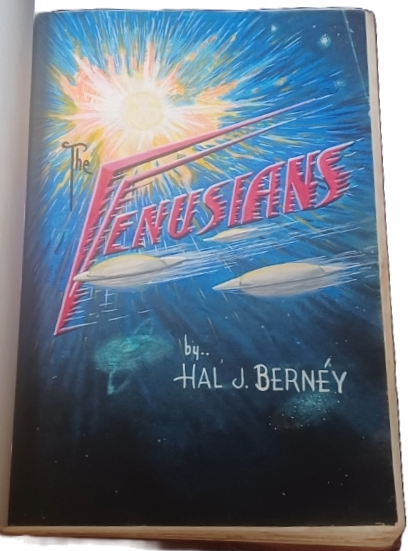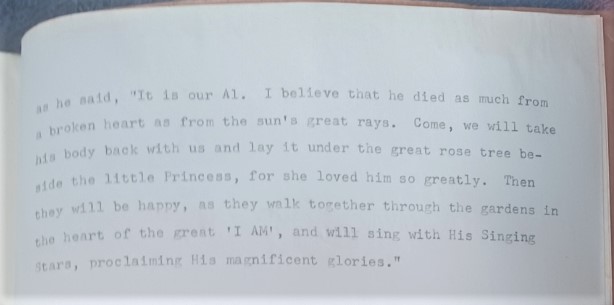 |
| The Venusians, text and images © Harold J. Berney Estate, 1960 and 2023. |
The first person convicted to prison for UFO-related crimes was the subject of an in-depth April 9, 2020, article at The Saucers That Time Forgot, “Harold J. Berney: The FBI's Flying Saucer Fugitive.” There’s been a new development, but first, for those who need it, a recap of the UFO-related part of his story.
In the mid-1950s, Harold Jesse Berney approached a few individuals and confided that he was working on a top-secret project based on alien technology. Once a prototype was manufactured, the U.S. government contract would guarantee any early investors an enormous return. Hal was an interesting character, charismatic, an inventor, a talented artist, but all of that was overshadowed by his lifelong penchant for fraud. He’s remembered chiefly as a sign painter and swindler. The key thing that led to his downfall and conviction was a book he had written about flying saucers and aliens.
Berney’s story was the same thing he was telling investors, that he’d been hired by the U.S. government to study the technology of a captured flying saucer. Shortly after setting foot on the craft, he was contacted by an alien and accepted the invitation to go to Venus to learn about their technology. Upon his return, he worked with a major government contractor to build the powerful Magnetic Flux Modulator for the defense of the United States
In 1956, Berney worked with Pauline E. Goebel, a major investor, a legal secretary by profession. She typed up his story into a 118-page manuscript, Two Weeks on Venus, saved until the Modulator project was no longer secret. When she got word that Berney had died on another trip to Venus, Pauline tried to recoup the investment of her life savings by taking the manuscript to a publisher. After hearing her story, they suggested she call the police because she’d been swindled. From there, the FBI took over, and when they caught Berney, he claimed to be innocent of fraud, the book “just fiction.” To avoid the maximum penalty, on October 3, 1957, Berney agreed to a guilty plea for lesser crimes, two charges of fraud. He spent about three years in prison, and after his release he went back to work as a sign painter in Silver Spring MD, until his death in 1967. Hal’s name stayed out of the papers, and as far as the world knew, he had no other UFO-related activity.
Other than a patent application, none of his drawings, paintings or writings are known to have survived. The sole manuscript for Berney’s Two Weeks on Venus was never published, taken by the FBI as evidence in Berney’s trial, afterwards filed with case records. UFO historians have never gotten to examine the text to see if it was merely derivative of early 1950 Contactee tales or was an original science fiction story. Depending on years of waiting for a FOIA response seemed the only hope of seeing it. It came as a delightful surprise to learn, "No, there is another."
A Warehouse Find
In August of 2023, The Saucers That Time Forgot received an unexpected message in reply to our 2020 article on Berney. It stated, “I have a copy of the actual draft The Venusians by Hal J Berney… with hand painted art…” I texted the number provided, and the following conversation revealed that the book had been found in a Virginia warehouse (over 100 miles from Berney’s last home) and the owner knew nothing about it, or how it got there. Pictures were also sent, about a dozen photographs of a massive manuscript bound in a scrapbook.
The scrapbook has a hand painted cover of the title, The Venusians, and the book itself is about 525 (single-sided) pages long, including hand-painted illustrations. The author is listed as Hal J. Bernéy, emphasizing that his last name was pronounced not like burn-ee, but like burr-nay.
Examining the photos of the text and illustrations, it indicates that this was Berney’s second attempt at a book. It was made after his conviction, and some of the paintings were made while he was incarcerated. One of the illustrations includes the year 1960 next to Berney’s signature.
An introductory page stated:
“The Venusians
A web of uncontrollable circumstances
This book is the culmination of the controversial manuscript… though at the time was called ‘Two Weeks on Venus’ was merely the outline basis for the now completed book named ‘The Venusians’.
A Fiction Novel by Hal J. Berney”
A following page emphasized the story as presented as a work of fiction:
“There are no true names of persons used in this book. Any similarity to names of persons living or dead is coincidental and not intended as such. The use of names of hotels, corporations, laboratories, Army and Navy personnel, Governments or courts are used fictionally, and do not imply their true connection in any actuality; while the laws in court procedures are correctly stated in a degree in their use, and then surrounded by fiction. The book is written in ambiguous obscureness, and is endowed with intricate, scientific facts. It is felt compulsory by the author to so state here, for his welfare, that the contents of this book are fiction.
Author: Hal J. Berney
Edited by: Lorene D. Wells”
The Venusians was greatly expanded from the tale begun in Berney’s unpublished Two Weeks on Venus, and the second half of the book continued the story far beyond the events of including his trial for “Conspiring to Defraud through False Pretense.” Harold J. Berney’s character is called “Albert J. Carlton,” and his company, “The Venusian Corporation of America.”
Here are a few pages and illustrations from the manuscript that were sent as examples:
 |
| Double-page fold out: “Milky Way and our Galaxy Map.” |
Figures approaching to examine a landed flying saucer.
 |
| “The ship had a flat concaved circular orbit-like band around the center of its ball shape.” |
A scene discussing the scientists who would manufacture the Venusian technology on earth.
In Berney’s fictionalized trial, The Grand Jury charged Al Carlton of perpetrating:
“a scheme that disrupted and stagnated the Corporation and its investors and the deliveries of the necessary ships to the United States Government, thus not only depriving the Government, but his investors, and leaving the entire Nation unprotected by the lack of the Venusian ships, and at the mercy of other foreign powers who might obtain the invention from the Defendant.”
 |
| The “North American Nebula” |
There wasn’t enough shown to reveal the entire story, but it seems the existence of the Venusians visitors were revealed in some kind of public disclosure. There was a scene of a crowd of people gathered under a phenomenal night sky.
 |
| “As they sat huddled together, the air seemed filled with soft strange music, as if some great choir of thousands of people were singing heavenly praises." |
I AM
Part of the story involved an ill-fated interplanetary romance. Al Carlton had fallen in love with a Venusian princess, but they were separated by her untimely death. Somehow, after his trial, Berney’s character traveled back to Venus. At the end, Al died in an accident and was buried beside the princess. The closing page describes their bittersweet reunion with a religious acknowledgment of “the great ‘I AM’.”
There’s been no documentation found, but there seems to be some overlap between Berney and the spiritual Contactees and the I AM followers, even if they were only among his prey in his investment schemes.
Lost and Found
Prior to this discovery, no one had a clue that the book existed. So far, no further information has been found about it, or Lorene D. Wells, the woman who helped Berney produce it. What will happen to The Venusians? The people who found the manuscript contacted me to get information on the author for the purpose of selling it. I gave them the background on Berney and put them in touch with his surviving relatives. Ideally, the manuscript will find a home with Berney’s family, and that scans of the document are made and made available to researchers. As of this writing, the final fate of the book has yet to be determined.
. . .
Connections? Two Flying Saucer Corporations
I've been unable to connect Hal Berney to any saucer club, but there was a lot of UFO-related activity nearby. Berney lived in Washington, D.C., but conducted business in Delaware, Pennsylvania, and Maryland. Flying saucer inventor Otis T. Carr's home and office was in Baltimore, Maryland, and there’s some interesting similarities between the two. They both had studied art, but neither of them had a formal education beyond the eighth grade. In the early 1950s, both started developing flying saucer technology, were granted patents for inventions, and incorporated businesses.
Harold J. Berney’s Telewand Corp. sought investors for his “Magnetic Flux Modulator.”Otis T. Carr’s OTC Enterprises Inc. sought investors for his “Utron Electric Accumulator.”
Berney’s Modulator was a box unit that produced "its own power by drawing energy from the atmosphere.” Carr’s Utron produced “free energy” to power “a fourth dimensional space vehicle... the OTC-X1 circular-foil spacecraft.”
 |
| Carr holding Utron Electric Accumulator, 1957. |
Both attracted believers in Contactee lore, but Carr was far more public in recruiting investors. Carr employed a publicist, Margaret Storm (author of Return of the Dove - a Theosophical biography of Nikola Tesla as a Venusian). Alice Beulah Schutz as a stenographer, and as A.D.K. Luk, she wrote Law of Life, a book for the “I AM” saucer-related religious cult. Whether through her or another source, Berney was aware of the religion and prominently featured a mention of “I AM” in the closing line of his book.
A Distinctive Saucer Design
The typical UFO of the day was pictured like a saucer or an automobile hubcap. Another distinctive saucer design debuted around 1957, a windowless elliptical fuselage ringed by an orbit-like band around its center. In Carr’s colorful spiral-bound pamphlet, published in October 1957, “OTC Enterprises, Inc, Brings You Atoms For Peace,” there was a spectacular illustration of his concept for a “Fourth Dimensional Space Vehicle.” The original art hung in his office and replicas and 17 x22 inch lithographs of the picture were offered to the public.
 |
| 1957 Carr publicity photo. |
The photo of Carr in front of the picture seems to show the artist’s signature in the bottom right corner, but it was cropped out of the published versions. While the identity of the artist is unknown, his space scene and the distinctive flying saucer design look very much like the work of Hal Berney, and an identical design appears on the cover of The Venusians. Berney and Carr’s flying saucers looked like they all came from the same factory on Venus.
Berney was arrested in March 1957 and was sentenced to prison in Oct. (about the time Carr printed the brochure). The book and art apparently began during or after his prison sentence, one picture is dated 1960. Without documentation, all we can say is that it’s possible Berney saw Carr’s saucer and copied it for his book cover. They are too similar in style and design to ascribe to coincidence.
Similar Fates
Both Berney and Carr were charged with crimes related to their flying saucer investment schemes.































